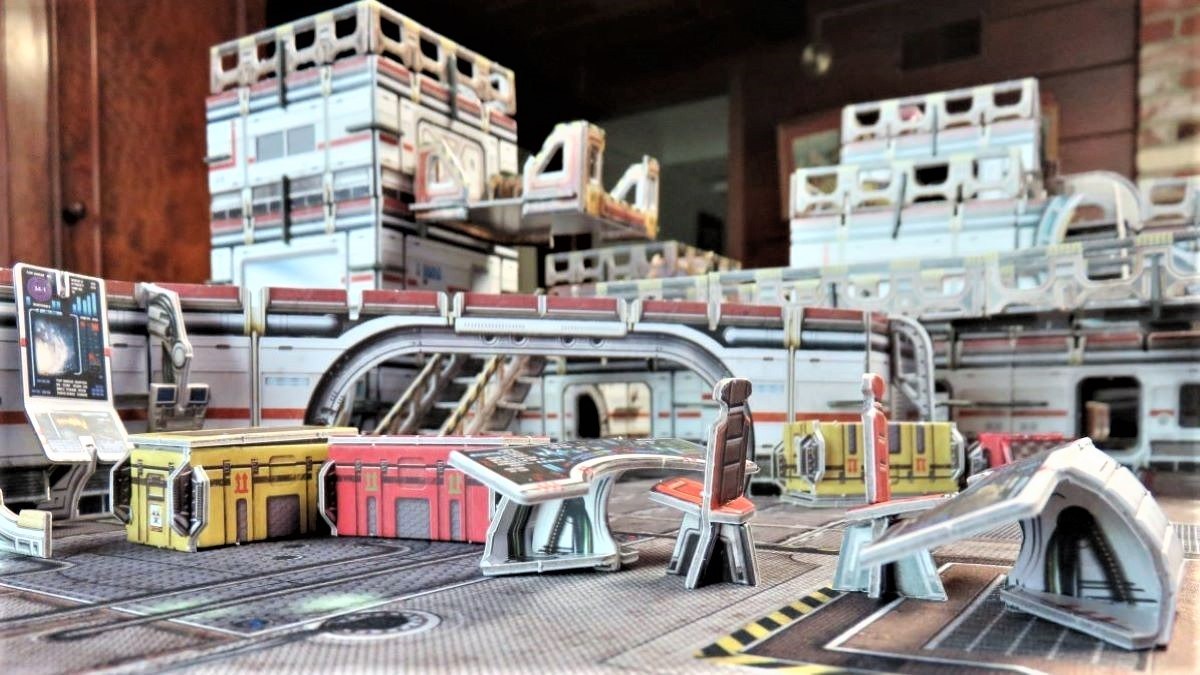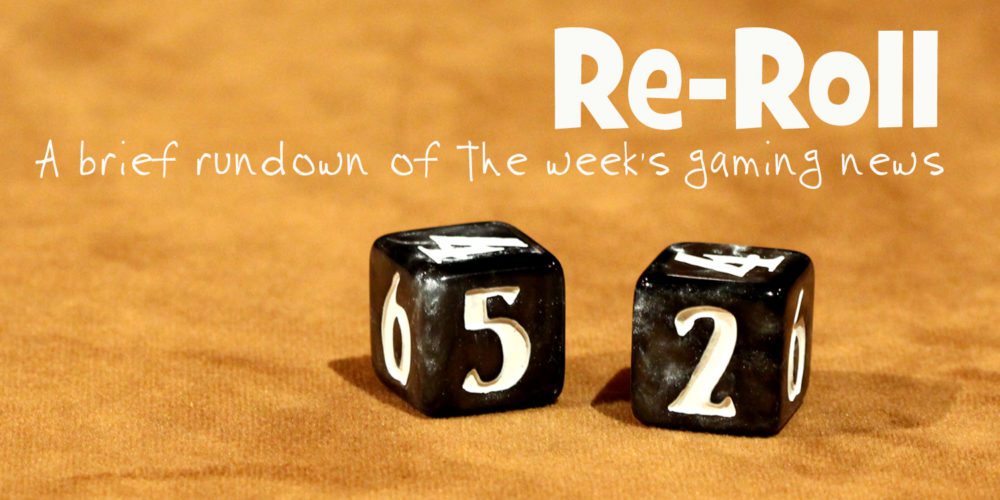Ready to breathe a little life into your gaming table, without blowing your kid’s college fund? Then read on!
What Is Battle Systems Galactic Core Set Sci-Fi Terrain?

Battle Systems Sci-Fi Terrain is high-quality, die cut modular card terrain suitable for 28mm tabletop miniatures. It comes flat packed and ready to assemble, and there are multiple compatible ranges available, including Frontier, Outlands, Cyberpunk, and Gothic. It can be used for a wide variety of games, from roleplaying games such as Starfinder and Shadowrun to tabletop miniature games like Warhammer 40K, Necromunda, and Infinity.
For this review, I will be focusing on the Galactic Core Set, which retails for £79.99 ($99.04 USD at the time of this writing). It is available online from Battle Systems, as well as at select local games stores.
Galactic Core Set Components
- 1 Printed Neoprene Gaming Mat 2′ x 2′ / 600mm x 600mm
- 54 Assorted Walls
- 30 Standard Walls
- 12 Hatchway Walls & Doors
- 9 Half Walls
- 3 Half Wall Hatchways & Doors
- 1 Large Roof/Floor Tile
- 6 Small Roof/Floor Tiles
- 12 Struts
- 6 Ladders
- 6 Arc Struts
- 7 Assorted Gantries
- 27 Assorted Railings
- 3 Grav-Elevators
- 3 Staircases
- 2 CO2 Scrubbers
- 2 Conduits
- 3 Storage Lockers
- 1 Wide Arc Doorway
- 1 Wide Airlock Door
- 2 Arc Doorways
- 1 Airlock Door
- 1 Force Field Door
- 2 Large Wall Display
- 4 Large Cargo Crates
- 4 Small Cargo Crates
- 2 Consoles
- 1 Command Table
- 2 Control Panel
- 5 Assorted Chairs
- 3 Wall Lockers
- 3 Work Stations
- 1 Reactor Chamber
- 2 Bunks
- 3 Wall Consoles
- 43 Assorted Scatter Components
- 120 Plastic Clips
Everything comes packed in a surprisingly small box, measuring 12 1/4″ x 9″ x 2 3/4″, and weighing 5 pounds, two ounces. Opening the box, you’ll first find this folded neoprene mat:

Then the assembly clips, ready to punch out:

And finally, the main event…all of the card terrain sheets:

As you can see, that’s a thick stack of card! In addition to the walls pictured above, here are the other sheets that you’ll be punching out for your terrain:






All of the sheets are double-sided, giving walls different artwork on both the interior and exterior sides. Floor tiles and gantries have two sides: one is a cleaner, more “Star Trek” look for the Galactic Core Set, and the Frontier side is dirtier and more industrial, like you’d see in something like “Firefly.”

This gives you a lot of flexibility in your setups, especially when you’re combining two or more of the different sets of Battle Systems terrain.
Overall, I found the components to be of very high quality. The graphic design and printing on both the card sheets and the battle mat are superb. The only issue that I had was with the neoprene of the battle mat itself. I unfolded it from the box, and after several days of allowing it to lie flat it, it looked like this:

There were large creases and folds that refused to go away. Concerned, I contacted Battle Systems, and they told me that on a rare occasion they have had defective mats. They sent me out a new one, folded up in the same way as the original mat shipped in the Galactic Core box. I took it out of the box and laid it out flat, and this is how it looked the next morning:

As you can see, this mat is greatly improved over the original that shipped with the set. I searched online to see if other people had the same problem that I’d had with creasing in the mats, and it seems that I just had bad luck of the draw. While you should expect that there will be some creases in the neoprene mats when you first take them out of the box, these should go away over time.
Assembling The Galactic Core Set
Reading over the components list, you may have noticed one seemingly glaring omission: an instruction guide. That’s because there isn’t one! Instead, you will find this single sheet inside of the box, directing you to their website for instructions on assembling the terrain.

I had mixed feelings on this. On the one hand, I love having a physical manual, where I can follow along with the instructions step by step. But on the other hand, the videos are relatively short, and very helpful in demonstrating how to put together the various terrain pieces, as well as how to avoid assembly pitfalls.
So, let’s say you’ve just received your Galactic Core box from Battle Systems. How do you go from this:

To this?

The first step is punching everything out. Thankfully, whatever printer Battle Systems uses to have their terrain printed and die-cut does an exceptional job. All of the pieces punch out easily from the card, though you will want to take extra care with the smaller, thinner pieces that are found on the consoles and equipment sheets. If you enjoy punching out tokens for board games, you’re going to love this part of the assembly!
While punching the pieces out, I occasionally wasn’t as careful as I should have been, and part of the printed paper would pull away from the rest of the card, as seen on side of the ladder below:

This wasn’t ever a big deal though, as a little bit of Elmer’s glue easily fixed the problem.
Once all the pieces are punched out, it’s time to put them together. Most of the terrain goes together without needing any glue. Walls and floors assemble easily using plastic clips slotted into them.


While the essential quick start guide tutorial video tells you to keep a hobby knife or clippers handy in case you need to widen any of the slots in the terrain pieces, I only found it necessary to do so in around three out of the over three hundred pieces included in the set.
Furniture and equipment, such as the consoles, chairs, crates, and oxygen scrubbers, assemble by slotting card pieces directly into other pieces instead of using plastic clips. The fit is generally very good, and most pieces require no glue whatsoever to assemble. However, if you are planning on leaving the equipment pieces assembled, they often benefit from a little glue to help keep them together.

When assembling any of the terrain, you want to be careful to apply even pressure on pieces and not push too hard, otherwise you can bend or crush the card. This is likely the reason that Battle Systems has age-rated their terrain as 14+; smaller, less patient children could find the assembly frustrating, and you could easily end up with broken pieces. For example, I had difficulties with this first chair I assembled, and you can see that the crosspiece in the base of the chair ended up crushed where it meets the seat. While it is still usable, it’s not exactly attractive, and is very difficult to get it to sit flat on the game mat. My subsequent chairs came out much better, so lesson learned.

Finally, there is one additional, optional step you can take with your Battle Systems terrain, if you want everything to look the best it possibly can. If you have a set of colored markers, you can color in the edges of your terrain pieces to match the artwork, as I did with this crate:


From the comparison above, you can see that by adding red and black to the edges of the small crate, I’ve given it that extra bit of polish that can really make the terrain pieces pop. But whether it’s worth it in time and effort for the end result is entirely up to each individual.
To really get a good feeling for working with Battle Systems terrain, I decided to try my best to recreate the layout shown on the back of the box:

Unlike a building system like LEGO, Battle Systems doesn’t provide any instructions or video tutorials for larger builds, so it’s up to you to figure out how to make a layout. Here’s what I ended up with, going solely from the above photo:

Not bad, and only took about an hour! Though if you compare the two pictures you can probably see that I’m missing a few pieces on the bottom right side of the layout. Often times in tabletop skirmish games, you’ll want to leave one side of a building open, to more easily place the miniatures as you move them about the battlefield. After assembling everything, I realized that I would have had enough pieces in the Galactic Core Set to fully recreate the picture on the box, if only I had made the buildings with three walls instead of a full four.
You can’t have miniature terrain without throwing some miniatures on it, right? I’m woefully behind in my painting, but I figured I could quickly muster one halfway decent mini to throw onto the board. So say hello to Carl the Chaos Space Marine, as he takes a brief tour of the station:



Why You Should Try Battle Systems Terrain
As a longtime tabletop miniatures gamer, I know the importance of having terrain for your gaming table. In the past, I’ve done most of my gaming at my local games store, where they’ve kept a decent supply of terrain on hand.
But since my move from Los Angeles last year, I haven’t had a nearby store hosting tabletop games. So what am I to do? I can host games myself, but then I would have to provide the terrain. There are two main stumbling blocks to owning a lot of miniature terrain: the money to buy it with, and the space to store it. A lot of the miniature terrain currently out on the market is plastic or resin, fairly costly, and requires you to store it fully assembled, as I discussed in my earlier preview of Battle Systems’ Fantasy Terrain Kickstarter.

With Battle Systems terrain, the cost is actually quite reasonable for the sheer amount of terrain you’re getting, and all those walls and floors can easily be disassembled and stored flat. That 2×2 terrain layout, once broken down, will fit in a box or tub on a Kallax shelf alongside your board games.
Some people really love the hobby aspect of assembling classic miniature terrain- they get great pleasure from gluing together the plastic pieces, painting the finished buildings, and flocking the bases. Which can be very rewarding, but also very time consuming, and requires certain hobby skills which not everyone has. If that’s what you love about working with miniature terrain, then Battle Systems may not be for you.
But if you want some miniature terrain that assembles quickly, that looks great thanks to its detailed artwork, and can fill a gaming table on a budget, then I highly recommend the Galactic Core Set from Battle Systems.
![]() To subscribe to GeekDad’s tabletop gaming coverage, please copy this link and add it to your RSS reader.
To subscribe to GeekDad’s tabletop gaming coverage, please copy this link and add it to your RSS reader.
Click here to see all our tabletop game reviews.
Disclosure: GeekDad received a copy of this game for review purposes.





